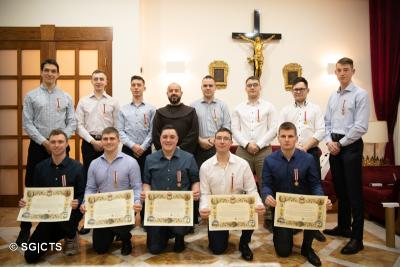The pilgrimage by the Swiss Guards in the Holy Land came to an end on Sunday 19th March. It was the first after the forced pause imposed by the pandemic. The tradition of the Swiss Guards’ pilgrimage started seven years ago, on the initiative of the Vatican military chaplain who realized how important it would be for these young men, at the service of the Church and of the Pope, to visit and pray in the places of the salvation of the Mother Church of Jerusalem. Since then, about ten pilgrimages have been made by this special military corps, founded by Pope Julius II in 1506 and which in particular looks after the security and the protection of the Pope.
Used to seeing them in the Vatican in their official Renaissance uniform in blue, red and dark yellow, during their stay in the Holy Land the Swiss Guards wore civilian clothes and visited all the most important places. Not only Jerusalem, but also Galilee, the desert of Judaea. Jericho and the site of the Baptism on the River Jordan and Bethlehem, where they had the chance to get to know the Baby Caritas Hospital, the children’s hospital founded by a Swiss donor.
“During this pilgrimage, with these twelve young men, like the Apostles,” admits fr. Alberto Joan Pari, secretary of the Custody of the Holy Land, who guided the group for the whole week, “I tried a little to imagine what the daily life of the Apostles with Jesus could have been like. I felt as though I were on the side of the “teacher”, because together, every day, we broke bread – both Eucharistic and of the Word – at every sanctuary we visited, each with its own specific catechism, liturgy, and theology: it was a very important and moving experience even for me. The particularity of this trip, the first after two and a half years, is that it let them visit those places which are at the historical root of the State they serve.”
For all these young Swiss, most of whom French speakers, it was an experience lived with joy, emotion and enthusiasm. Before their departure, the trip had been prepared at length with meditations, prayers, Bible readings and lectures, so that it would be a deeper, more responsible and more conscious experience.
“The pilgrimage for the Swiss Guards is organized every year: going to the Holy Land is a dream for us who work in the Vatican alongside the Holy Father,” admits Mike Boget, who has been a Swiss Guard for four years, “because Jerusalem and the Holy Land are at the root of our faith: being here means returning to where it all started and above all at last being able at last to “see” the Bible we read and know fairly well. We know now that seeing these places in real life is a special grace, which perhaps we do not realize yet.”
Florent Jacquod, who has served in the Vatican for two and a half years now, emphasizes how what most impressed him the most was the “situation of the Christians in the Holy Land: the places are very beautiful and have to be preserved for the collective memory, of course, but they are the “living stones” of this land. I think that this is a really beautiful image: the Christians are the “living” memory of our faith and exactly just as the sanctuaries were built to preserve and protect the memory of the places, we have to give support and protect the people who live here.” Martin Constantin joins in the enthusiasm for this trip: “In our everyday life, we always want to “be doing” something, our time is fully taken up with work and other activities, whereas here we can stop for a moment and reflect what the meaning of our life is based on.”
At the end of the pilgrimage, the Swiss Guards received the Pilgrim’s Medal at the Curia of the Custody and the relative parchment certificate, the honour that Pope Leo XIII wanted as an attestation of the pilgrimage and a visible sign of the experience the pilgrims had had and that was sculpted in their hearts.
By Silvia Giuliano | custodia.org






